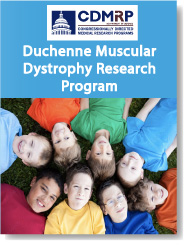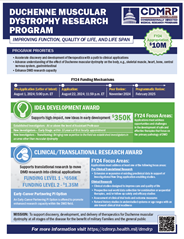Duchenne Muscular Dystrophy
Vision – To preserve and improve the function and quality of life, and to extend the life span of all individuals with DMD

» Click on Image to View Program Booklet

» Click on Image to View Strategic Plan

» Click on Image to View Program Overview
Duchenne muscular dystrophy (DMD) affects approximately 1 out of every 3,500 male infants (about 20,000 new cases a year). This form of muscular dystrophy results from mutations in the dystrophin gene that lead to an absence of dystrophin in muscle cells, allowing these cells to be easily damaged. Boys living with DMD experience devastating muscle weakness that affects the skeletal muscles, heart, and respiratory muscles. Symptoms of DMD typically develop prior to age 5, and by age 12 most patients are confined to a wheelchair. Currently, there is no cure for DMD and young men with this disease rarely live beyond their early 30s. Over the past several years, research has identified many novel therapeutic targets and significantly expanded the number of potential therapeutics in the pipeline for DMD. The DMDRP aims to accelerate the transformation of these promising therapeutic ideas into clinical applications and support the training of new physician researchers to encourage careers in DMD research.
![]()
Congressional Appropriations
- $69.6 million
FY11-23 - $10 million
FY24

Funding
Summary
- 87 Awards in FY11-23
- Recent Applications Recommended for Funding

Programmatic
Panels

Peer Review Participants
Muscular Dystrophy Coordinating Committee (MDCC)
Last updated Thursday, March 20, 2025














